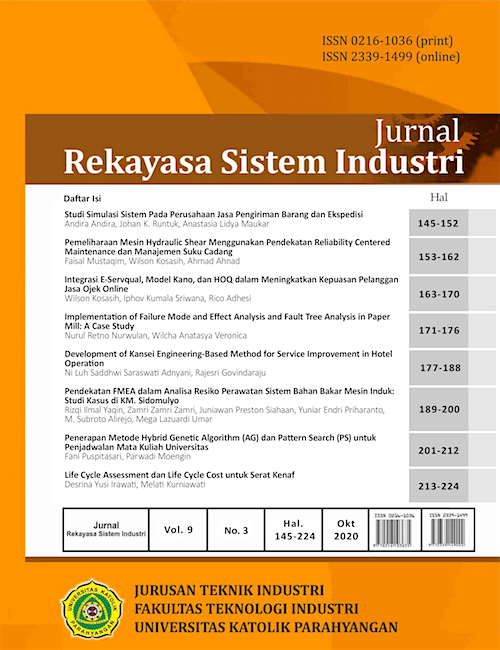Integrasi E-Servqual, Model Kano, dan HOQ dalam Meningkatkan Kepuasan Pelanggan Jasa Ojek Online
DOI:
https://doi.org/10.26593/jrsi.v9i3.4043.163-170Abstract
Online motorcycle taxi service providers become business opportunities that grow and develop. The development of digital business opportunities is also supported by the increasingly widespread service users. This research aims to determine the characteristics of online motorcycle taxi service users and the attributes that are priority for users. In this study, several methods are used and integrated include: e-ServQual, IPA (importance-performance analysis), Kano Model, and House of Quality. The measurement result of the consumer satisfaction index is 55.58%, meaning that the consumers are quite satisfied with the online service. Based on the findings of this study, the attributes prioritized by consumers are the punctuality of the driver's arrival as stated in the application (attribute 14), the driver confirms the customer's order quickly (attribute 15), and the driver is easy to obtain (attribute 17). Finally, this study also recommends corrective actions to these service providers, among others: maintaining server reliability with a relative importance of 21.4%, regularly conducting driver training with a relative importance of 15.2%, and increasing the number of drivers with a relative importance 4.3%.References
Aditiawarman, B. P. (2000). Pengukuran Tingkat Kepuasan dan Identifikasi Ketidakpuasan Pelayanan (Studi Kasus: Saving and Lending Unit Sucofindo). Skripsi yang tidak dipublikasikan. Bogor, ID: Departemen Matematika dan Ilmu Pengetahuan Alam, Institut Pertanian Bogor.
Ahmad & Kosasih, W. (2013). Pengukuran Tingkat Kepuasan PelangganTerhadap Layanan di Bengkel XYZ dengan menggunakan Metode SERVQUAL, IPA, dan Kano. Paper presented at The 8th SNMI (TI-36). Jakarta, ID: Jurusan Teknik Mesin, Fakultas Teknik, Universitas Tarumanagara.
Ali, M., Kharis, A. & Karlina, D. (2018). Faktor-faktor yang Menjadi Pertimbangan dalam Penggunaan Jasa Ojek Online (Go-Jek) di Kota Mataram. Jurnal Ilmu Administrasi Publik, 6(2), 75-84.
Amajida, F.D. (2016). Kreativitas Digital dalam Masyarakat Risiko Perkotaan: Studi Tentang Ojek Online “Go-Jek” di Jakarta. INFORMASI Kajian Ilmu Komunikasi, 46 (1), 115-127.
Cohen, L. (1995). Quality Function Deployment: How to Make QFD Work for You. Reading Mass: Addison-Wesley.
CQM. (1993). A Special Issue on Kano’s Methods for Understanding Customer Defined Quality. Center for Quality of Management Journal, 2(4), 3-36.
Dwijoko, A. & Sterya, H. (2017). Motorcycles as Transport Service Based on Smart Phone Android Applications. Paper presented at The 6th International Conference of Euro Asia Civil Engineering Forum. MATEC Web of Conferences 138, 07001. DOI: 10.1051/matecconf/201713807001.
Gasperz, V. (2012). All-in-One®: Practical Management Excellence. Jakarta, ID: Vinchristo Publication.
Kano, N., Seraku, N., Takahashi, F., & Tsuji, S. (1984). Attractive Quality and Must-be Quality. Journal of the Japanese Society for Quality Control, 14(2), 39-48.
Martilla, J.A. & James, J.C. (1977). Importance-Performance Analysis. Journal of Marketing, 41, 77-79.
Nofirza, Kus Indrayani. (2011). Aplikasi Metode Kano dalam Analisis Indikator Kualitas Layanan di Rumah Sakit Arifin Ahmad Pekanbaru. Jurnal Sains, Teknologi dan Industri, 9(1), 1-8.
Parasuraman, A., Zeithaml, V.A., & Berry, L.L. (1985). A Conceptual Model of Service Quality and Its Implications for Future Research. Journal of Marketing, 49, 41-50.
Parasuraman, A., Zeithaml, V.A., & Berry, L.L. (1988). SERVQUAL: A Multiple-Item Scale for Measuring Consumer Perceptions of Service Quality. Journal of Retailing, 64, 12-40.
Rangkuti, F. (2003). Measuring Customer Satisfaction. Jakarta, ID: PT. Gramedia Pustaka Utama.
Tjiptono, F. & Chandra, G. (2007). Service, Quality, Satisfaction. Edisi kedua. Yogyakarta, ID: CV. Andi Offset.
Wolfinbarger, M. & Gilly, M.C. (2003). eTailQ: Dimensionalizing, Measuring, and Predicting eTail Quality. Journal of Retailing, 79, 183-198.
Zeithaml, V.A, Berry, L.L., & Parasuraman, A. (1993). The Nature and Determinants of Customer Expectations of Service. Journal of Academy of Marketing Science, 21(1), 1-12.

